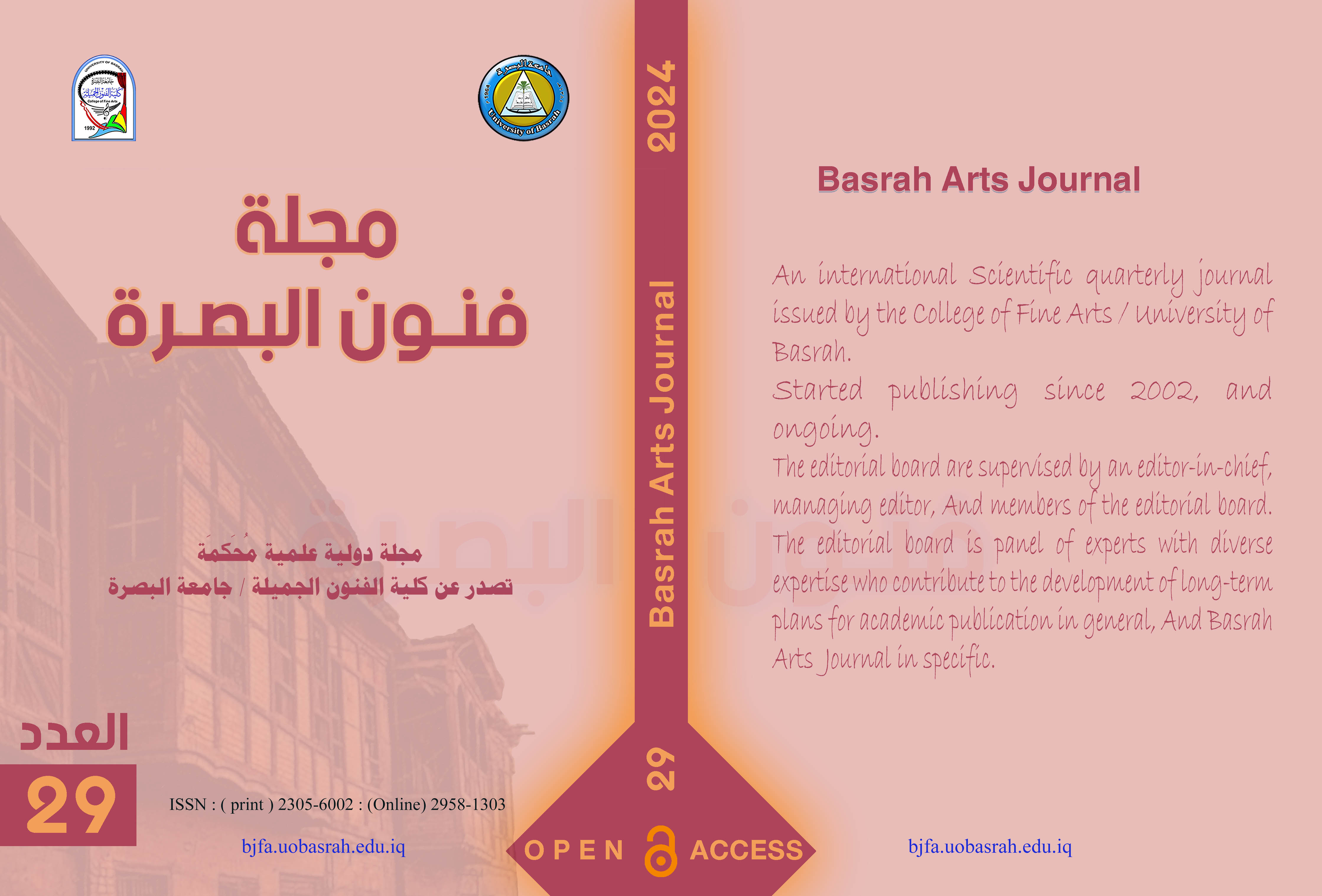الرموز الثقافية في رسوم الجدران بين العراق وايطاليا
دراسة مقارنة
DOI:
https://doi.org/10.59767/2024.05/29.2الكلمات المفتاحية:
الجدار، الگرافيتي، رسوم، الرموزالملخص
يتناول البحث الموسوم (الرموز الثقافية في رسوم الجدران بين العراق وايطاليا - دراسة مقارنة) تنوع الرموز الثقافية واستعاراتها واساليب التعبير عنها لكل شعب من الشعوب بشكل عام وللعراق وايطاليا على وجه التحديد, ويقع في اربعة فصول, الاول يمثل الاطار المنهجي ويتضمن مشكلة البحث واهميته وهدفه وحدوده وتعريف المصطلحات وتضمن الثاني الاطار النظري واشتمل على ثلاث مباحث: مدخل فكري للثقافة وتعالقاتها, الجذر التاريخي والمفهومي لرسوم الجدران, التمثلات الرمزية للثقافة في رسوم الجدران, وتضمن الفصل الثالث اجراءات البحث وتحليل عينته التي تضمنت ثلاثة رسوم من كل بلد وخلصت الباحثة الى جملت نتائج منها:
1. تتسم الرموز الثقافية في رسوم الجدران العراقية باستعارات محددة وبانحسارها على جدران العزل الكونكريتية, بينما في رسوم الجدران الايطالية فتخضع الرموز الثقافية لحقل مرجعي واسع وتنتشر في معظم فضاءات المدينة.
2. في رسوم الجدران العراقية، معظم الرموز الثقافية تمتاز بأشكال ايقونية والوان وصفية، بينما في رسوم الجدران الايطالية فمعظم الرموز عبارة اشكال كتابية ورمزية الوان اصطلاحية تنبني على مفهوم الاختلاف وكسر التوقع وتحقيق الصدمة.
3. في رسوم الجدران العراقية تؤسس الرموز الثقافية تكوينات زخرفية تؤدي وظيفة ترويحية لا تكشف عن وعي الدور الحضاري للنسق، اما في رسوم الجدران الايطالية فتؤسس الرموز الثقافية تكوينات جمالية تؤدي وظيفة تعبيرية ثقافية وهي تعي الدور الحضاري للنسق.
وتمت مناقشتها واستخلاص الاستنتاجات.
المراجع
Abbas, M. A., & Al-kinani, A. A. (2022). Intellectual Implications of the Duality of Mother and Child in the Social Perspective. Journal for Educators, Teachers and Trainers(4), pp. 229–237. doi:https://doi.org/10.47750/jett.2022.13.04.032
Abdel-Ghani, I. (2012). euronews. Retrieved from The symbolic dimension in culture, a study published in the Information Network: www.euronews.com
Adel, A.-A. (2014). The Writing on the Walls of Rome an article published in the Information Network. Retrieved from almada: www.almada.com
Al-Nusair, Y. (2005). The symbolism of the wall in art between the concept of the wall and the formation. Retrieved from tshkeely: www.tshkeely.com
Collingwood, R. G. (1966). Principles of Art. (A. Hamdi, Trans.) Cairo: Egyptian House of Writing.
Critics, A. G. (2010). Culture and Culture in the Twentieth Century. (H. Ali, Trans.) Baghdad: Dar Al-Mamoun.
Culture. (2015). euronews. Retrieved from Graffiti art revives tourism in the poor neighborhoods of Rome, article published in the Information Network: www.euronews.com
Dewey, J. (1963). Art is Experience. (Z. Ibrahim, Trans.) Cairo: Arab Renaissance House.
Graffiti. (2008). Retrieved from maxformus: www.maxformus.net
Jean Marie, et al. (1973). Structuralism. (M. Makhoul, Trans.) Damascus: Ministry of Culture and Guidance.
Mercia, A.-B. (1991). Manifestations of the Myth. (N. Khayatah, Trans.) Damascus: Dar Kanaan.
Mid, H. G. (1984). Mind, Self & Society. Chicago: University Press.
Minnelli, L. (2010). From the Streets to the Museums. (E. Hadi, Editor) Retrieved from grafitti: www.grafitti.com
Peir, N. (n.d.). French Cultural Revolution. Retrieved from daneillesinger: www.daneillesinger.org
Peter, B. (1995). Modernity and Beyond. (A. W. Alloub, Trans.) Abu Dhabi: Cultural Foundation.
Ralph, L. H. (1969). culture&Human beings in Recent Anthropology. London.
researchers, A. g. (1985). Encyclopedia of Iraqi Civilization (Vol. Part 1). Baghdad.
Saliba, J. (1971). The Philosophical Dictionary (Vol. Part 1). Beirut: Dar Al-Kitab Al-Libnani.
Salloum, F. (n.d.). Walls of isolation/space of freedom and formation. Retrieved from IraqArt: www.IraqArt.com
Wikipedia. (n.d.). The free encyclopedia. Retrieved from wikipedia: www.wikipedia.com
التنزيلات
منشور
كيفية الاقتباس
الرخصة
الحقوق الفكرية (c) 2024 Rana Hazim Saeed (Author)

هذا العمل مرخص بموجب Creative Commons Attribution 4.0 International License.







